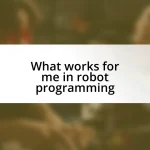Key takeaways:
- The PCB fabrication process involves a series of precise steps, including design, etching, and drilling, requiring meticulous attention to detail to avoid costly errors.
- Common PCB issues include solder mask misalignment, copper thinning, and dimensional tolerances, emphasizing the importance of early detection and routine inspections.
- Essential troubleshooting tools include oscilloscopes, thermal cameras, and multimeters, which aid in diagnosing electrical and physical defects on PCBs.
- Preventative measures such as detailed documentation, designing for manufacturability, and regular process audits are crucial for minimizing fabrication issues.
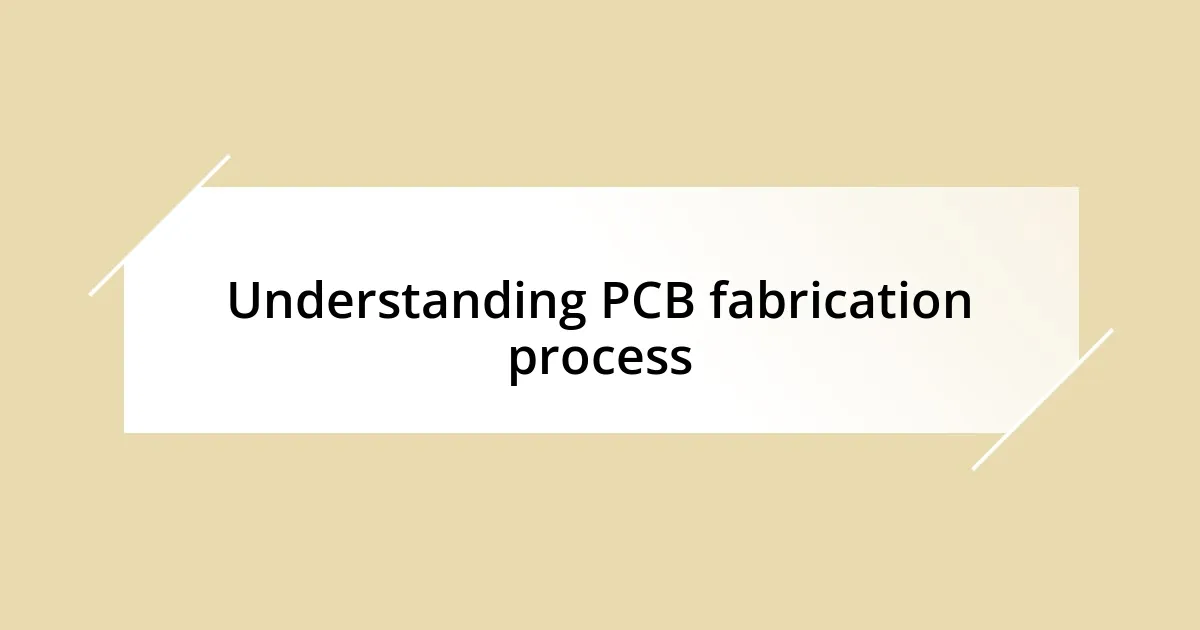
Understanding PCB fabrication process
The PCB fabrication process is a fascinating journey that begins with a design, typically created in software like Altium or Eagle. I recall the first time I saw a design I’d worked on come to life as a physical board; it was like watching a blueprint transform into a tangible reality. It’s this intricate process that allows our electronics to function as intended.
Once the design transfers to a photomask, a series of chemical and physical processes begin. Think of it like cooking; every ingredient must be measured and prepared with precision. As I once learned the hard way, neglecting even a single step can lead to issues down the line, making me appreciate the dedication required to ensure each board is crafted perfectly.
Then comes the etching and drilling, where copper layers are precisely cut away to shape the circuits. This step always amazed me because it’s where artistry meets engineering. Have you ever considered how delicate and complex these little pathways are? It’s a reminder of how intricately our modern world is designed, and every tiny mistake can ripple through the final product.
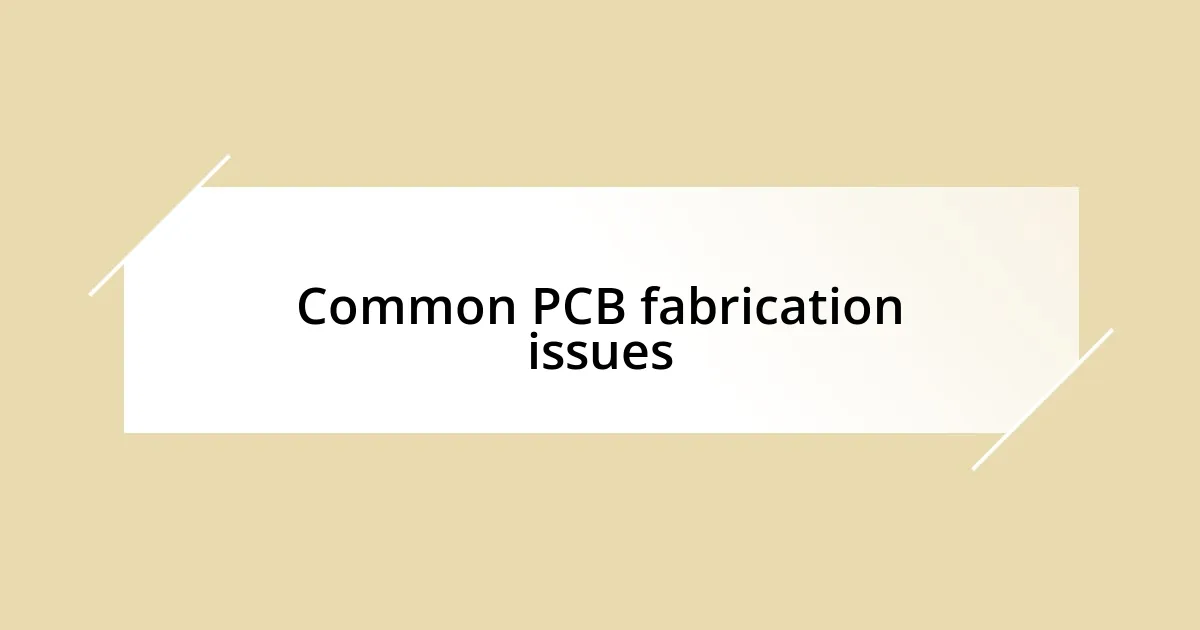
Common PCB fabrication issues
In my experience, several common issues can arise during PCB fabrication, often catching even seasoned professionals off guard. I still remember the anxiety I felt the first time I discovered a misalignment in solder mask registration on one of my projects; it was like watching a clock come apart at the seams. Such errors can not only halt production but also lead to costly reworks, making it essential to identify and address them early on.
Here are some specific issues you might encounter:
- Solder Mask Misalignment: When the solder mask doesn’t align with the pads, it can hinder solder flow and create poor connections.
- Copper Thinning: Inadequate plating during the fabrication process can lead to weak connections and increase resistance.
- Dimensional Tolerances: Deviations in board dimensions can cause components to misfit during assembly, creating major headaches.
- Environmental Contamination: Particles or moisture can affect the surface finish, leading to poor solderability.
- Etching Irregularities: Over- or under-etching can result in circuit pathway issues, disrupting the connectivity of the board.
Caught up in the hustle of fabrication, it’s easy to overlook these pitfalls. I always remind myself that spotting these issues early can save time, money, and sleepless nights down the road. But let me tell you, there’s nothing quite like the relief I felt after implementing a routine inspection process, which significantly reduced the frequency of these common errors.
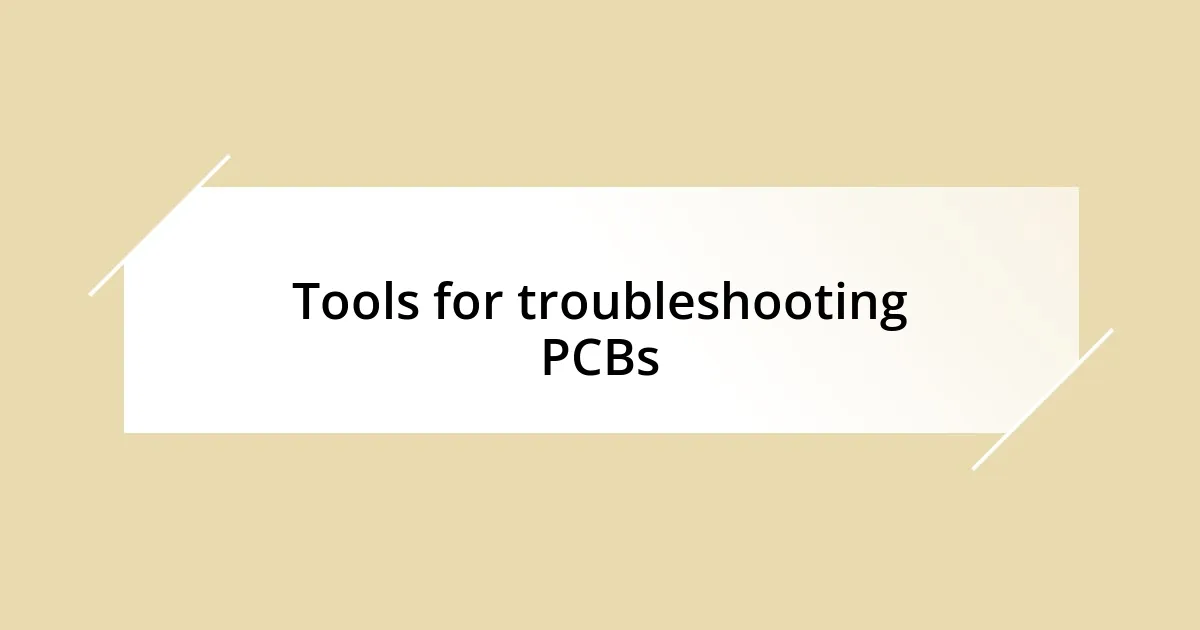
Tools for troubleshooting PCBs
When it comes to troubleshooting PCBs, having the right tools is crucial. In my hands-on experience, oscilloscopes and multimeters have been my go-to instruments. An oscilloscope lets me visualize voltage changes over time, revealing issues in signal integrity that a simple multimeter might miss. I remember the first time I used one; it felt like gaining X-ray vision. Suddenly, I could see what was happening inside the circuits in real-time, which was a game-changer for my troubleshooting process.
Another essential tool is the thermal camera. This nifty gadget allows me to spot overheating components, which often signal potential failures. I vividly recall a project where a particular chip was overheating but looked fine on the outside. The thermal camera did its work, highlighting the issue vividly, saving me from a bigger disaster down the line. It’s amazing how technology can give us insights we might miss otherwise.
Lastly, I can’t underestimate the power of good old-fashioned visual inspection tools, like a magnifying glass or a microscope. These tools help catch physical defects like solder bridges or cracks in the board. I once spent hours troubleshooting a malfunctioning circuit only to find that a tiny solder bridge was the culprit. It was both frustrating and enlightening at the same time, teaching me to never underestimate the smaller details.
| Tool | Key Characteristic |
|---|---|
| Oscilloscope | Measures voltage over time for signal analysis |
| Multimeter | Tests voltage, current, and resistance for basic diagnostics |
| Thermal Camera | Identifies overheating components visually |
| Magnifying Glass | Enables close inspection for physical defects |

Step by step troubleshooting guide
When troubleshooting PCB fabrication issues, I often start with a visual inspection of the board. There’s something almost meditative about the process, as I study every inch for signs of misalignment or contamination. Have you ever spent time just examining a board only to catch minor details that could have led to significant problems? I remember spotting a faint discoloration on a PCB that ended up being moisture damage. That moment reminded me of the importance of taking a thorough approach.
Once the visual inspection is done, I turn my attention to measuring the electrical characteristics of the board. I often start with a multimeter to confirm that voltages are within expected ranges. The first time I had to deal with a component not responding as expected, I felt a rush of panic. Was it the PCB, or was it the component? Checking connections meticulously with the multimeter not only eased my worries but also pinpointed the real issue—a faulty resistor that went unnoticed earlier. It’s moments like these that really drive home the value of systematic troubleshooting.
Next, I might use the oscilloscope to delve deeper into signal integrity issues. The first time I saw the waveforms on the screen, it was akin to unlocking a new level of understanding in my projects. Is the signal clean, or is there noise? There’s a particular joy in solving these puzzles, knowing that each layer of analysis gets me closer to a resolution. I once resolved a communication failure between two components simply by adjusting the length of a trace, which reduced interference. It’s a reminder that even the smallest details can carry significant weight in the grand scheme of PCB design.
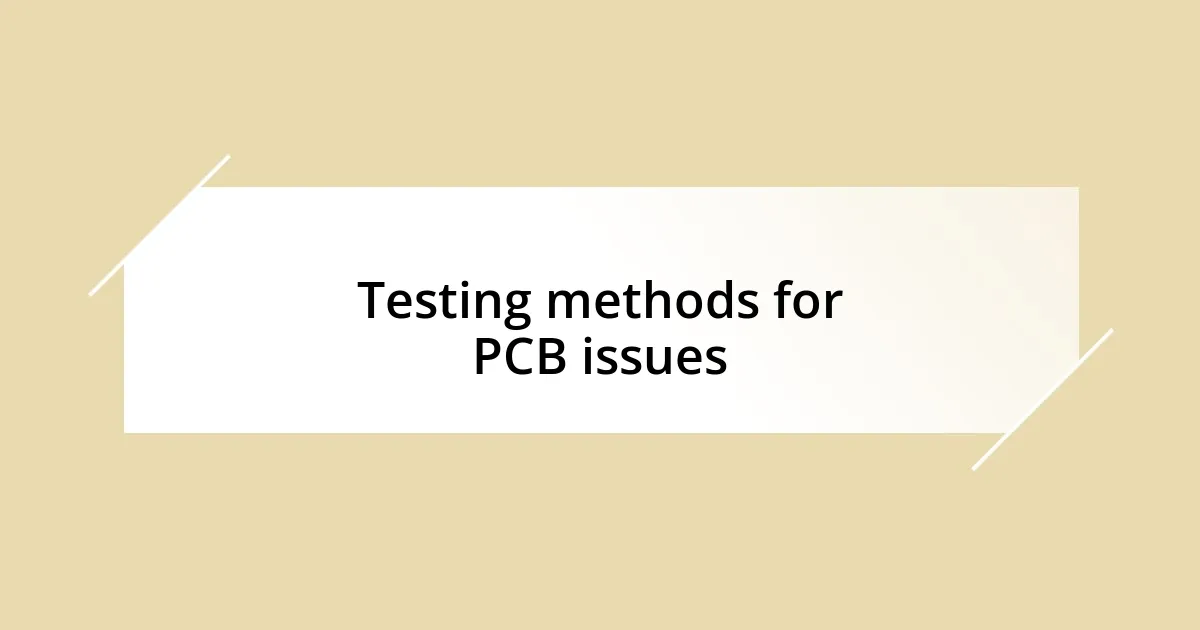
Testing methods for PCB issues
When I encounter potential issues during PCB troubleshooting, I often employ a variety of testing methods. One approach I continually find effective is using in-circuit testing (ICT). This method checks the functionality of individual components while they’re still on the board. Have you ever thought about how many hidden defects could exist beneath your eyes? I once discovered a faulty capacitor on a board, which only became apparent when I ran an ICT. It was a revelation that something so small could disrupt the whole system.
Another technique I leverage is boundary scan testing, especially for complex designs with dense components. This approach utilizes special test access ports embedded in the ICs. The first time I used boundary scan, it was a bit like opening a secret door to my circuit’s inner workings. I remember troubleshooting a multilayer PCB where conventional methods fell short. Boundary scan gave me an entirely new perspective, allowing me to test connections that were otherwise unreachable. It’s amazing how sometimes the solution lies just outside the norm.
Lastly, I often find myself using functional testing at the end of the troubleshooting process. This method involves powering up the board and verifying that it performs its intended tasks. I reflect on a project where I was convinced everything was perfect, only to find during functional testing that a power supply was underperforming. That moment was humbling, reminding me that the real-world application can reveal issues that lab tests sometimes miss. Have you faced similar surprises in your work? It reinforces the idea that practical application is the ultimate judge of any design.

Best practices for preventing issues
When it comes to preventing PCB fabrication issues, I can’t stress enough the importance of detailed documentation. Keeping thorough records of designs, revisions, and material specifications has saved me countless headaches. Have you ever traced a problem back to a small change that you forgot to note? I once modified a trace width and skipped documentation; it ended up being a nightmare during assembly. This experience taught me that a little diligence up front can save a lot of time down the line.
Another best practice I advocate is designing for manufacturability (DFM). By ensuring that my designs are optimized for the fabrication process from the beginning, I often sidestep common pitfalls. I vividly recall a project where I realized too late that my pad sizes were not suitable for the pick-and-place machinery. The frustration was palpable, but it reinforced my commitment to DFM principles. Taking the time to consult with manufacturers during the design phase has been a game-changer for me; their insights can often illuminate potential issues long before they become problematic.
Finally, I advocate for regular reviews and audits of the fabrication process itself. Engaging with the production team has revealed a treasure trove of insights. For example, during a factory visit, I noticed discrepancies in material handling that could have led to contamination. It made me question how often we assume our processes are flawless without validating them firsthand. That experience taught me that communication and collaboration with manufacturing personnel is vital; sometimes, the key to preventing issues lies in addressing the human element in the process.

Documenting and analyzing findings
When it comes to documenting and analyzing findings, I believe meticulous note-taking is non-negotiable. Each time I discover an issue, I immediately jot down details such as symptoms, tests conducted, and the steps taken to troubleshoot. I remember a particularly challenging project where I neglected this step and regretted it when I struggled to recall earlier observations. Wouldn’t it be a relief to have everything laid out clearly? Trust me, it saves time and frustration later.
As I analyze my findings, I often create flowcharts or diagrams to visualize the problem-solving process. One time, I drew out a complex chain of connections that led to an intermittent failure, revealing a pattern I hadn’t noticed before. It’s fascinating how connecting the dots on paper can spark insights that elude you in verbal discussions. Have you considered how visual representation can make complex issues more manageable? Turning findings into a visual format can often simplify decisions and bring clarity to chaotic troubleshooting scenarios.
Finally, I find that revisiting past issues can yield valuable lessons. After navigating through a challenging PCB issue, I often sit back to review my documentation and reflect on what worked and what didn’t. I recall a moment of triumph when I recognized a recurring theme in my failures—an oversight in the component placement that had gone unnoticed. Have you taken the time to learn from your past challenges? This practice of reflection not only sharpens my skills but also reinforces the idea that every setback is an opportunity for growth.
